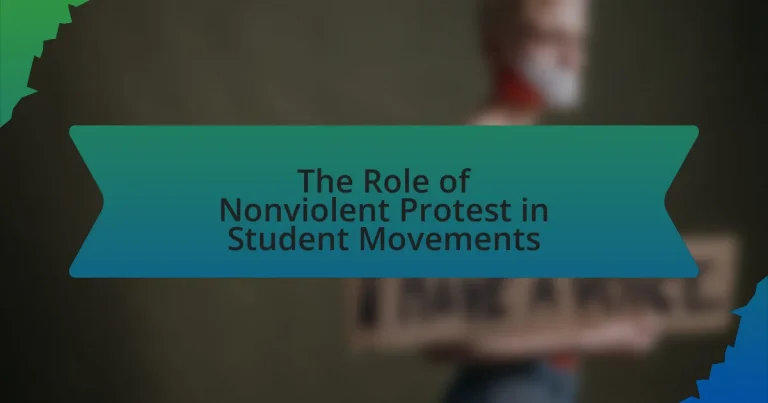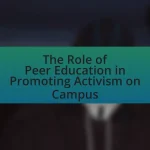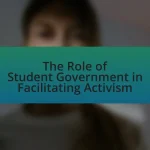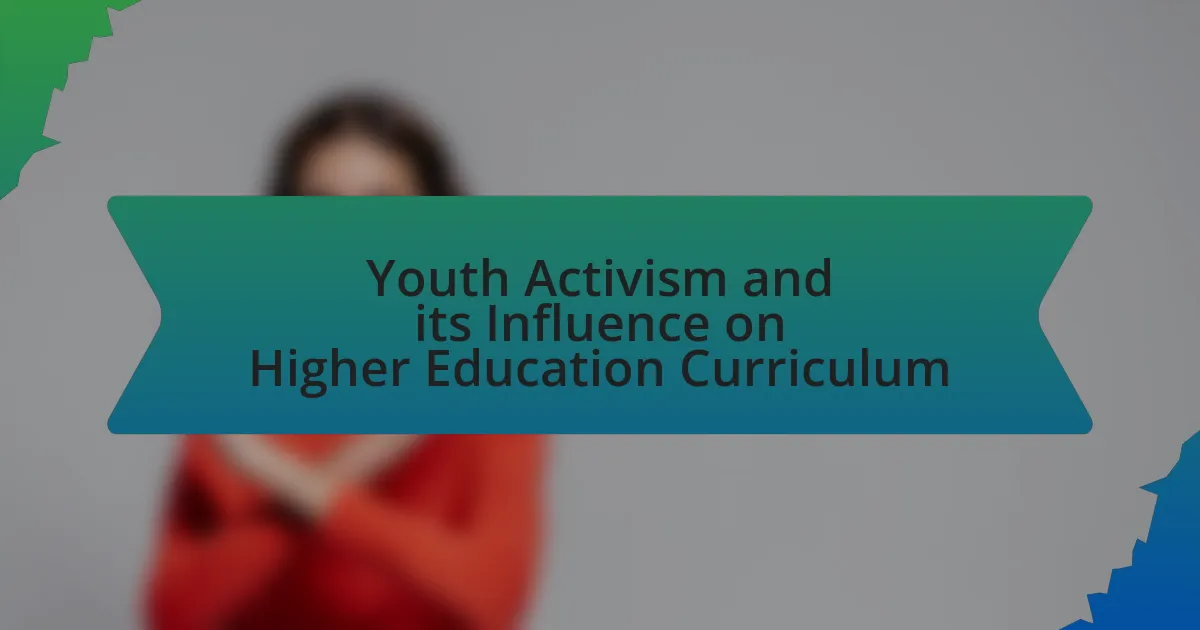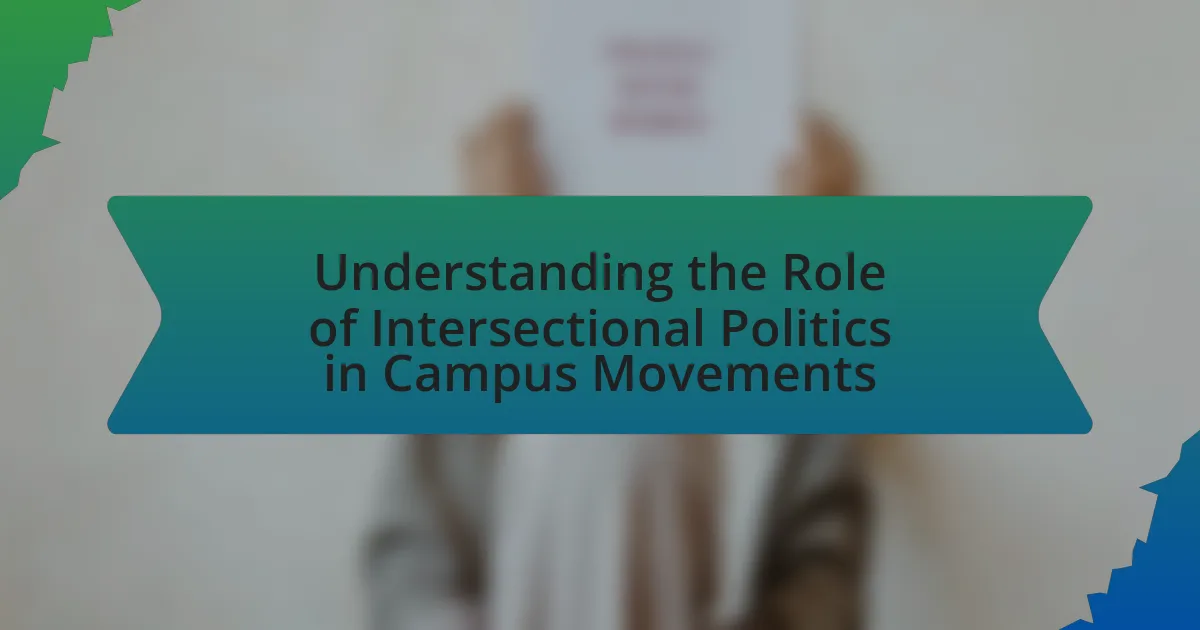The article examines the critical role of nonviolent protest in student movements, highlighting its effectiveness in fostering dialogue and achieving social change without resorting to violence. It discusses historical examples, such as the Civil Rights Movement and the Free Speech Movement, illustrating how nonviolent strategies have successfully mobilized students and influenced public policy. The article also addresses the challenges faced by student movements, including government repression and internal divisions, while emphasizing best practices for organizing effective nonviolent protests. Additionally, it explores the impact of social media and technology in mobilizing support and maintaining unity among diverse student groups.
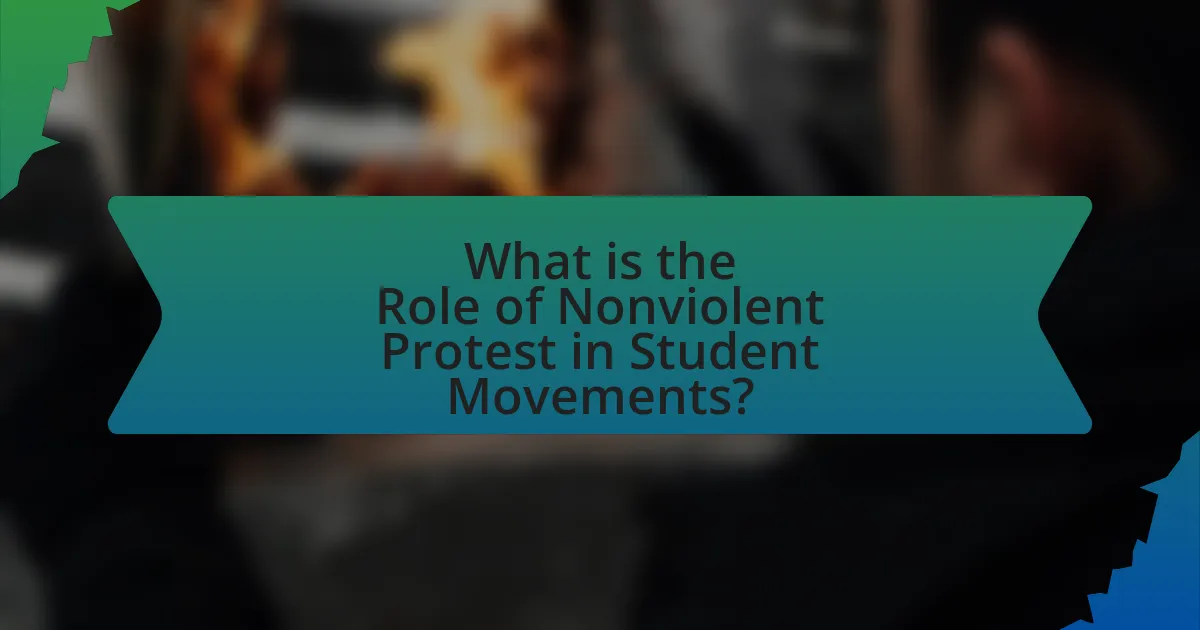
What is the Role of Nonviolent Protest in Student Movements?
Nonviolent protest plays a crucial role in student movements by enabling collective action without resorting to violence, thereby fostering a more inclusive and effective dialogue with authorities. Historical examples, such as the Civil Rights Movement in the United States, demonstrate that student-led nonviolent protests, like sit-ins and marches, can successfully challenge systemic injustices and influence public policy. Research indicates that nonviolent movements are more likely to achieve their goals, with a study by Chenoweth and Stephan showing that nonviolent campaigns are twice as effective as violent ones in bringing about political change. This effectiveness stems from the ability of nonviolent protests to garner broader public support and maintain moral high ground, which is essential for sustaining momentum in student movements.
How has nonviolent protest shaped student movements historically?
Nonviolent protest has significantly shaped student movements historically by providing a strategic framework for activism that emphasizes moral authority and broad public support. For instance, during the Civil Rights Movement in the United States, student-led organizations like the Student Nonviolent Coordinating Committee (SNCC) utilized nonviolent tactics such as sit-ins and marches, which not only drew national attention but also inspired similar movements globally, including the anti-apartheid struggle in South Africa. The effectiveness of these methods is evidenced by the successful desegregation of public spaces and the eventual passage of civil rights legislation, demonstrating how nonviolent protest can mobilize students and create substantial social change.
What key events exemplify nonviolent protest in student movements?
Key events that exemplify nonviolent protest in student movements include the 1964 Free Speech Movement at the University of California, Berkeley, and the 2011 Occupy Wall Street protests. The Free Speech Movement was characterized by students advocating for their right to free speech and political activity on campus, leading to significant policy changes. The Occupy Wall Street protests involved students and activists peacefully demonstrating against economic inequality, which sparked a global movement. Both events highlight the effectiveness of nonviolent strategies in mobilizing student activism and influencing societal change.
How did these events influence broader societal changes?
Nonviolent protests in student movements significantly influenced broader societal changes by promoting civil rights and social justice. These events, such as the sit-ins during the Civil Rights Movement, galvanized public awareness and support for racial equality, leading to legislative changes like the Civil Rights Act of 1964. The effectiveness of nonviolent strategies demonstrated the power of collective action, inspiring future movements, including anti-war protests and environmental activism, which further reshaped societal norms and policies. The widespread participation of students in these protests highlighted the importance of youth voices in advocating for change, ultimately contributing to a more engaged and politically aware society.
Why is nonviolent protest preferred in student movements?
Nonviolent protest is preferred in student movements because it fosters inclusivity and encourages broader participation. This approach minimizes the risk of violence, which can alienate potential supporters and lead to negative public perception. Historical examples, such as the Civil Rights Movement led by Martin Luther King Jr., demonstrate that nonviolent strategies can effectively mobilize communities and achieve significant social change without resorting to aggression. Additionally, research indicates that nonviolent movements are more likely to succeed in achieving their goals, as evidenced by a study published in the Journal of Peace Research, which found that nonviolent campaigns are twice as effective as violent ones in bringing about political change.
What are the ethical considerations behind nonviolent protest?
The ethical considerations behind nonviolent protest include the principles of justice, respect for human rights, and the moral obligation to seek change without inflicting harm. Nonviolent protest aims to challenge injustices while maintaining the dignity of all individuals involved, which aligns with ethical frameworks that prioritize empathy and compassion. Historical examples, such as Martin Luther King Jr.’s civil rights movement, demonstrate that nonviolent approaches can effectively mobilize public support and create lasting social change without resorting to violence, thereby reinforcing the ethical stance that violence often perpetuates cycles of harm and retaliation.
How does nonviolent protest impact public perception of student movements?
Nonviolent protest positively impacts public perception of student movements by fostering empathy and support from the broader community. When students engage in peaceful demonstrations, they are often viewed as principled and committed to their cause, which can lead to increased public sympathy and solidarity. Historical examples, such as the Civil Rights Movement in the United States, illustrate that nonviolent actions, like the sit-ins and marches led by students, garnered significant media attention and public support, ultimately influencing legislation and societal attitudes. Research indicates that nonviolent protests are more likely to attract diverse participants and media coverage, enhancing the visibility and legitimacy of student movements.
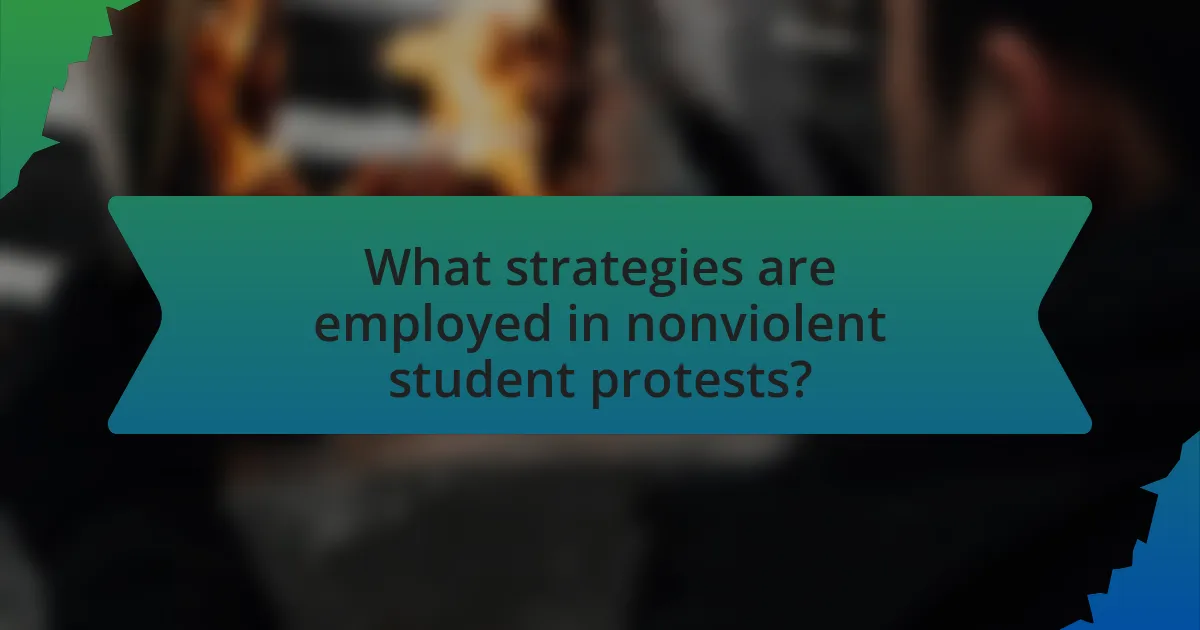
What strategies are employed in nonviolent student protests?
Nonviolent student protests employ strategies such as peaceful demonstrations, sit-ins, and awareness campaigns. These methods aim to draw attention to social or political issues without resorting to violence. For instance, sit-ins have historically been used to challenge segregation, as seen in the Greensboro sit-ins of 1960, where students occupied lunch counters to protest racial discrimination. Additionally, awareness campaigns leverage social media to mobilize support and disseminate information, exemplified by the #NeverAgain movement following the Parkland shooting in 2018, which organized students nationwide to advocate for gun control. These strategies effectively engage communities and influence public opinion while maintaining a commitment to nonviolence.
How do students organize nonviolent protests effectively?
Students organize nonviolent protests effectively by establishing clear goals, mobilizing support, and utilizing strategic planning. Clear goals provide direction and purpose, ensuring that all participants understand the objectives of the protest. Mobilizing support involves engaging fellow students, community members, and organizations to create a larger coalition, which enhances visibility and impact. Strategic planning includes selecting appropriate locations, timing, and methods of communication, such as social media, to disseminate information and rally participants. Historical examples, such as the 1960s Civil Rights Movement, demonstrate that effective organization leads to significant social change, as seen in the successful integration of public spaces and the passage of civil rights legislation.
What roles do social media and technology play in organizing protests?
Social media and technology serve as critical tools for organizing protests by facilitating communication, mobilization, and information dissemination. They enable activists to quickly share updates, coordinate logistics, and rally support across diverse geographic locations. For instance, during the Arab Spring, platforms like Twitter and Facebook were instrumental in organizing mass protests, allowing individuals to connect and share real-time information, which significantly contributed to the movements’ momentum. Additionally, studies have shown that social media can increase participation rates in protests; a 2018 study published in the Journal of Communication found that social media engagement correlates with higher turnout at demonstrations. Thus, the integration of social media and technology fundamentally transforms the landscape of protest organization, enhancing the ability of movements to gain visibility and support.
How do students mobilize support from the community?
Students mobilize support from the community by organizing events, engaging in outreach, and leveraging social media platforms. These actions create awareness about their causes and foster community involvement. For instance, student-led initiatives often include town hall meetings, rallies, and informational sessions that invite community members to participate and voice their opinions. Research indicates that effective communication strategies, such as storytelling and sharing personal experiences, enhance community engagement and support. A study by the Harvard Kennedy School highlights that grassroots movements, particularly those involving students, can significantly influence public opinion and policy changes when they effectively mobilize local support.
What tactics are commonly used in nonviolent protests?
Common tactics used in nonviolent protests include sit-ins, marches, boycotts, and civil disobedience. Sit-ins involve occupying a space to disrupt normal activities and draw attention to a cause, as seen in the Greensboro sit-ins of 1960, which were pivotal in the American civil rights movement. Marches, such as the 1963 March on Washington, mobilize large groups to demonstrate solidarity and demand change. Boycotts, like the Montgomery Bus Boycott, leverage economic pressure to challenge unjust policies. Civil disobedience entails deliberately breaking laws to highlight their injustice, exemplified by Gandhi’s Salt March in 1930. These tactics effectively raise awareness and mobilize public support for social and political change.
How do peaceful demonstrations differ from other forms of protest?
Peaceful demonstrations differ from other forms of protest primarily in their commitment to nonviolence and the intention to promote dialogue rather than conflict. Peaceful demonstrations aim to express dissent and advocate for change without resorting to aggressive tactics, which can lead to violence or property damage, as seen in riots or confrontational protests. Historical examples, such as the Civil Rights Movement led by Martin Luther King Jr., illustrate how peaceful demonstrations can effectively mobilize public support and influence policy changes through nonviolent means, contrasting sharply with more aggressive forms of protest that may alienate potential allies and provoke backlash.
What are the most effective methods of nonviolent resistance?
The most effective methods of nonviolent resistance include civil disobedience, protests, strikes, and boycotts. Civil disobedience involves the active refusal to obey certain laws or commands of a government, exemplified by figures like Mahatma Gandhi and Martin Luther King Jr., who used this method to challenge unjust laws. Protests, such as marches and sit-ins, mobilize large groups to publicly demonstrate against oppression, as seen in the Civil Rights Movement. Strikes disrupt normal operations to demand change, effectively illustrated by labor movements that have historically led to significant reforms. Boycotts target specific businesses or products to exert economic pressure, successfully employed during the Montgomery Bus Boycott, which led to desegregation in public transportation. These methods have proven effective in achieving social and political change by raising awareness and mobilizing public support.
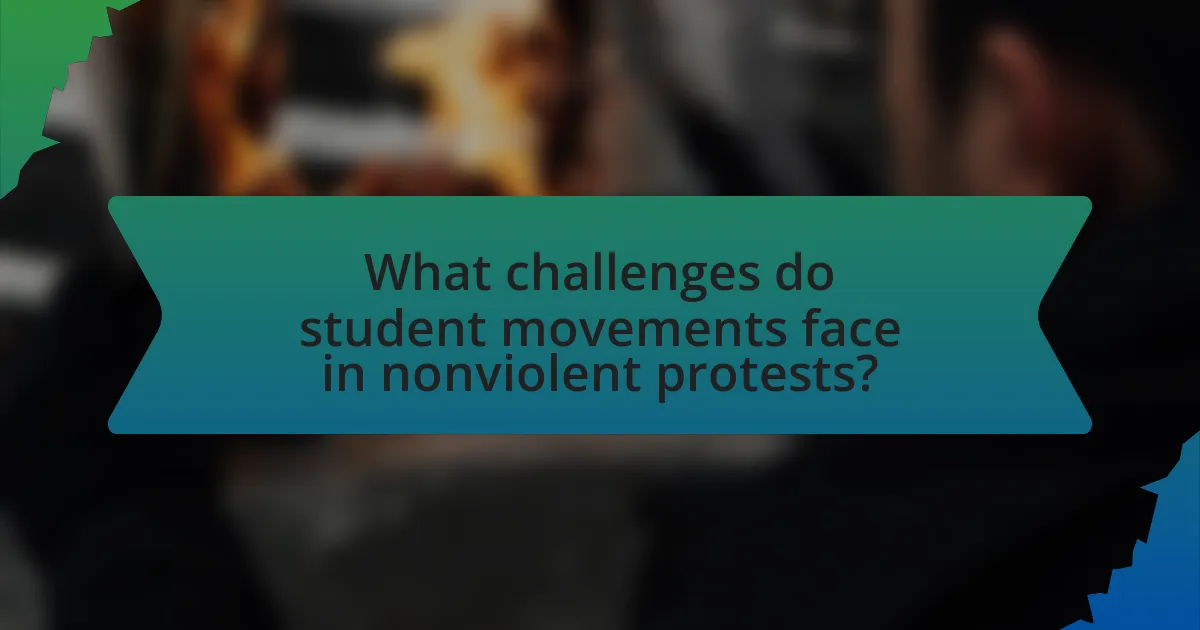
What challenges do student movements face in nonviolent protests?
Student movements face several challenges in nonviolent protests, including government repression, internal divisions, and public perception issues. Government repression often manifests as police violence, arrests, or legal actions against protesters, which can deter participation and intimidate activists. Internal divisions arise from differing ideologies or strategies among participants, leading to conflicts that can weaken the movement’s cohesion and effectiveness. Additionally, public perception issues can hinder support; nonviolent protests may be misinterpreted as ineffective or trivial, impacting the movement’s ability to garner broader societal backing. These challenges can significantly impede the success and sustainability of student-led nonviolent protests.
How do authorities respond to nonviolent student protests?
Authorities typically respond to nonviolent student protests by engaging in dialogue, monitoring the situation, and sometimes implementing policy changes. For instance, many educational institutions and local governments recognize the importance of student voices and may initiate discussions to address the concerns raised during protests. Historical examples include the 1960s civil rights protests, where authorities often negotiated with student leaders to find common ground. Additionally, research indicates that nonviolent protests can lead to significant policy reforms, as seen in the case of the 2011 Occupy Wall Street movement, which influenced discussions on economic inequality.
What legal challenges do student protesters encounter?
Student protesters encounter various legal challenges, including restrictions on their right to assemble, potential arrests for civil disobedience, and disciplinary actions from educational institutions. These challenges arise from laws that govern public assembly and protest, which can vary significantly by jurisdiction. For instance, in many areas, permits are required for large gatherings, and failure to obtain such permits can lead to legal repercussions. Additionally, student protesters may face university sanctions, such as suspension or expulsion, for participating in protests deemed disruptive. Historical examples include the 1960s civil rights protests, where students faced legal consequences for their activism, highlighting the ongoing tension between student rights and institutional regulations.
How can students navigate potential backlash from authorities?
Students can navigate potential backlash from authorities by employing strategic communication and building coalitions. Effective communication involves clearly articulating their goals and intentions, which can help mitigate misunderstandings and reduce the likelihood of punitive responses. For instance, historical examples like the Civil Rights Movement demonstrate that students who engaged in dialogue with authorities often faced less severe repercussions than those who did not. Additionally, forming coalitions with other organizations can amplify their voices and provide a united front, making it harder for authorities to target individual students. Research indicates that collective action can lead to more favorable outcomes, as seen in the 2011 Occupy Wall Street movement, where diverse groups collaborated to address shared concerns, thereby minimizing backlash.
What internal challenges do student movements face?
Student movements face several internal challenges, including fragmentation, leadership disputes, and ideological differences. Fragmentation occurs when various factions within the movement prioritize different goals, leading to a lack of unified action. Leadership disputes can arise when individuals or groups vie for control, causing paralysis in decision-making. Ideological differences often create rifts, as members may have varying perspectives on issues, which can hinder collective efforts. These challenges can weaken the overall effectiveness of student movements, as seen in historical examples like the anti-Vietnam War protests, where internal divisions limited their impact.
How do differing opinions within movements affect nonviolent strategies?
Differing opinions within movements significantly impact nonviolent strategies by creating divisions that can weaken collective action and dilute messaging. When participants in a movement hold conflicting views on goals, tactics, or ideologies, it can lead to fragmentation, making it challenging to present a unified front to authorities or the public. For instance, during the Civil Rights Movement, disagreements between leaders like Martin Luther King Jr., who advocated for nonviolent resistance, and Malcolm X, who supported more militant approaches, highlighted how divergent strategies could affect overall movement cohesion and effectiveness. This fragmentation can result in mixed messages that confuse supporters and undermine the movement’s credibility, ultimately hindering its ability to achieve its objectives.
What can be done to maintain unity among diverse student groups?
To maintain unity among diverse student groups, fostering open communication and mutual respect is essential. Implementing regular dialogue sessions allows students to share their perspectives and experiences, promoting understanding and collaboration. Research indicates that inclusive practices, such as organizing joint events and activities that celebrate cultural diversity, can enhance group cohesion. For instance, a study by the American Psychological Association found that collaborative projects among diverse groups lead to improved relationships and reduced prejudice. Therefore, creating platforms for interaction and shared experiences is crucial for sustaining unity among students from varied backgrounds.
What are best practices for successful nonviolent student protests?
Successful nonviolent student protests require clear objectives, strategic planning, and effective communication. Establishing specific goals helps unify participants and directs the protest’s message. Strategic planning involves selecting appropriate locations, timing, and methods of protest, such as marches or sit-ins, which have historically proven effective, as seen in the 1960s Civil Rights Movement. Effective communication ensures that the protest’s message reaches a wider audience, utilizing social media and traditional media to garner support and raise awareness. Research indicates that nonviolent movements are more likely to succeed in achieving their goals, as demonstrated by the success of the Arab Spring protests, which relied heavily on nonviolent tactics to mobilize large groups and attract international attention.
